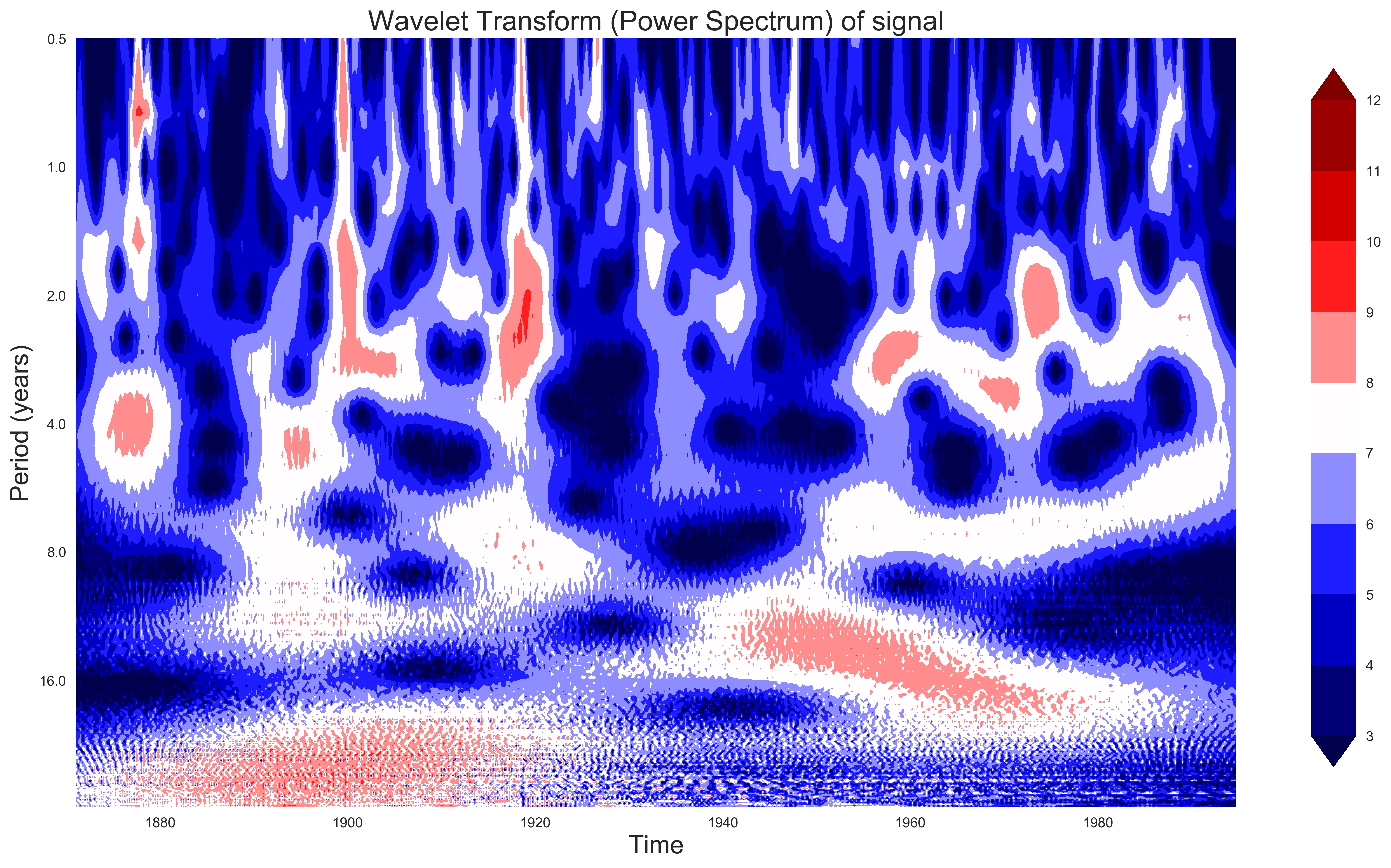Wavelet analysis applied to the real dataset in a quick and easy way (codes included)
An introduction to the wavelet analysis for a real geophysical data set. I compared the analysis to the Fourier analysis. Codes included!
A wavelet series represents a real or complex-valued function by a certain orthonormal series generated by a wavelet. We cannot easily explain wavelet transform with a basic understanding of the Fourier Transform.
Similar posts
Fourier Transform
The Fourier Transform is a useful tool to transform a signal from its time domain to its frequency domain. The peaks in the frequency spectrum correspond to the most occurring frequencies in the signal. The Fourier Transform is reliable when the frequency spectrum is stationary (the frequencies present in the signal are not time-dependent). However, the Fourier Transform of the whole time series cannot tell the instant a particular frequency rises.
A quick fix is to use a sliding window to find a spectrogram that gives the information of both time and frequency (famously known as Short-time Fourier transform). However, this uses the rigid length of the window and hence limits the resolution in frequency. This is due to the uncertainty principle (duration-bandwidth theorem) in signal analysis with a tradeoff in the frequency and time resolution (Papoulis 1977; Franks 1969), similar to the Heisenberg uncertainty principle in quantum mechanics for position and momentum of a particle.
Wavelet Transform
Since in geosciences, we work mostly with dynamical systems, most of the signals are non- stationary in nature. In such cases, the Wavelet Transform is a much better approach.
The Wavelet Transform retains high resolution in both time and frequency domains (Torrence & Compo 1998; Chao et al. 2014). It tells us both the details of the frequency present in the signal along with its location in time. This is achieved by analyzing the signal at different scales. Unlike the Fourier Transform that uses a series of sine waves with different frequencies, the Wavelet Transform uses a series of functions called wavelets, each with different scales to analyze a signal. The advantage of using a wavelet is that wavelets are localized in time unlike their counterparts in the Fourier Transform. This property of time localization of wavelets can be exploited by multiplying the signal with wavelets at different locations in time, starting from the beginning and slowly moving towards the end of the signal. This procedure is known as convolution. We can iterate the whole process by increasing the scale of the wavelet at each iteration. This will give us the wavelet spectrogram (or scaleogram). The scales are analogous to the frequency in the Fourier Transform. The scales can be converted to the pseudo-frequencies by the relation:
\begin{equation} \label{eq:costFunc} \begin{split} f_{\alpha} = \frac{f_{c}}{\alpha} \end{split} \end{equation}
where, \(f_{\alpha}\) is the pseudo-frequency, \(f_{c}\) is the central frequency of the mother wavelet and \(\alpha\) is the scaling factor. This relation shows that the higher scale factor (longer wavelet) corresponds to a smaller frequency. Hence, scaling the wavelet in the time domain can be used to analyze smaller frequencies in the frequency domain.
Wavelet Analysis applied on El Niño–Southern Oscillation sea surface temperature & Indian monsoon rainfall dataset
I apply the Wavelet analysis concept on the quarterly dataset for El Niño–Southern Oscillation (ENSO) sea surface temperature in degree Celsius (1871-1997) and Indian monsoon rainfall in mm (1871-1995) (Torrence & Webster 1999). The color pattern in the wavelet spectrogram is taken as log2(power). The wavelet used for this analysis is the complex Morlet wavelet with bandwidth 1.5 and normalized center frequency of 1.0. If the scale is too low, then aliasing due to the violation of Nyquist frequency may occur. If the scale is too large, the wavelet computation maybe is computationally intensive.
import pywt
import numpy as np
import matplotlib.pyplot as plt
import pandas as pd
plt.style.use('seaborn')
dataset = "monsoon.txt"
df_nino = pd.read_table(dataset, skiprows=19, header=None)
N = df_nino.shape[0]
t0 = 1871
dt = 0.25
time = np.arange(0, N) * dt + t0
signal = df_nino.values.squeeze() #to get the scalar values
signal = signal - np.mean(signal)
scales = np.arange(1, 128) #set the wavelet scales
def plot_signal(time, signal, average_over=5, figname=None):
fig, ax = plt.subplots(figsize=(15, 3))
ax.plot(time, signal, label='signal')
ax.set_xlim([time[0], time[-1]])
ax.set_ylabel('Signal Amplitude', fontsize=18)
# ax.set_title('Signal + Time Average', fontsize=18)
ax.set_xlabel('Time', fontsize=18)
ax.legend()
if not figname:
plt.savefig('signal_plot.png', dpi=300, bbox_inches='tight')
else:
plt.savefig(figname, dpi=300, bbox_inches='tight')
plt.close('all')
plot_signal(time, signal) #plot and label the axis
In the above code, I used the pandas read_table method to read the data in the monsoon.txt I’m not sure where I originally obtained the monsoon dataset, so I cannot cite the source. If anyone knows, please comment below. The above script uses the module wavelet_visualize for computing and plotting the figure below.

def get_fft_values(y_values, T, N, f_s):
f_values = np.linspace(0.0, 1.0/(2.0*T), N//2)
fft_values_ = np.fft.fft(y_values)
fft_values = 2.0/N * np.abs(fft_values_[0:N//2])
return f_values, fft_values
def plot_fft_plus_power(time, signal, figname=None):
dt = time[1] - time[0]
N = len(signal)
fs = 1/dt
fig, ax = plt.subplots(2, 1, figsize=(15, 3), sharex=True)
variance = np.std(signal)**2
f_values, fft_values = get_fft_values(signal, dt, N, fs)
fft_power = variance * abs(fft_values) ** 2 # FFT power spectrum
ax[0].plot(f_values, fft_values, 'r-', label='Fourier Transform')
ax[1].plot(f_values, fft_power, 'k--',
linewidth=1, label='FFT Power Spectrum')
ax[1].set_xlabel('Frequency [Hz / year]', fontsize=18)
ax[1].set_ylabel('Amplitude', fontsize=12)
ax[0].set_ylabel('Amplitude', fontsize=12)
ax[0].legend()
ax[1].legend()
# plt.subplots_adjust(hspace=0.5)
if not figname:
plt.savefig('fft_plus_power.png', dpi=300, bbox_inches='tight')
else:
plt.savefig(figname, dpi=300, bbox_inches='tight')
plt.close('all')
plot_fft_plus_power(time, signal)

def plot_wavelet(time, signal, scales, waveletname='cmor1.5-1.0', cmap=plt.cm.seismic, title='Wavelet Transform (Power Spectrum) of signal', ylabel='Period (years)', xlabel='Time', figname=None):
dt = time[1] - time[0]
[coefficients, frequencies] = pywt.cwt(signal, scales, waveletname, dt)
power = (abs(coefficients)) ** 2
period = 1. / frequencies
scale0 = 8
numlevels = 10
levels = [scale0]
for ll in range(1, numlevels):
scale0 *= 2
levels.append(scale0)
contourlevels = np.log2(levels)
fig, ax = plt.subplots(figsize=(15, 10))
im = ax.contourf(time, np.log2(period), np.log2(power),
contourlevels, extend='both', cmap=cmap)
ax.set_title(title, fontsize=20)
ax.set_ylabel(ylabel, fontsize=18)
ax.set_xlabel(xlabel, fontsize=18)
yticks = 2**np.arange(np.ceil(np.log2(period.min())),
np.ceil(np.log2(period.max())))
ax.set_yticks(np.log2(yticks))
ax.set_yticklabels(yticks)
ax.invert_yaxis()
ylim = ax.get_ylim()
ax.set_ylim(ylim[0], -1)
cbar_ax = fig.add_axes([0.95, 0.15, 0.03, 0.7])
fig.colorbar(im, cax=cbar_ax, orientation="vertical")
if not figname:
plt.savefig('wavelet_{}.png'.format(waveletname),
dpi=300, bbox_inches='tight')
else:
plt.savefig(figname, dpi=300, bbox_inches='tight')
plt.close('all')
plot_wavelet(time, signal, scales)

Final Result
For the analysis of the ENSO dataset [Figure below (a-d)], we see that most of the power is concentrated in a 2 to 8 year period (or 0.125-0.5 Hz). We can see that up to the year 1920, there were high fluctuations in power, while there were not so much after that. We can also see that there is a shift from longer to shorter periods as time progresses. For the Indian monsoon dataset [Figure below (e-h)], although the power is evenly distributed across different periods, there is also a slight shift in power from longer periods to shorter periods as time progresses. Thus, the Wavelet Transform helps in visualizing this kind of dynamic behavior of the signals.

(a) and (e) shows the time series in °C and mm, respectively for ENSO and Indian monsoon. (b) and (f) shows the Fourier Transform, (c) and (g) shows the Power spectrum of ENSO and Indian monsoon respectively.
References
This code was written for the purpose of the analysis in (1). If you use this code for publications, please cite (1).
- Kumar, U., Chao, B. F., & Chang, E. T.-Y. Y. (2020). What Causes the Common‐Mode Error in Array GPS Displacement Fields: Case Study for Taiwan in Relation to Atmospheric Mass Loading. Earth and Space Science, 0–2. https://doi.org/10.1029/2020ea001159
- Chao, B. F., Chung, W., Shih, Z., & Hsieh, Y. (2014). Earth’s rotation variations: A wavelet analysis. Terra Nova, 26(4), 260–264. https://doi.org/10.1111/ter.12094
- Franks, L. E. (1969). Signal theory.
- Papoulis, A. (1977). Signal analysis (Vol. 191). McGraw-Hill New York.
- Torrence, C., & Compo, G. P. (1998). A practical guide to wavelet analysis. Bulletin of the American Meteorological Society, 79(1), 61–78.
- Wavelet transform (Wikipedia)
Disclaimer of liability
The information provided by the Earth Inversion is made available for educational purposes only.
Whilst we endeavor to keep the information up-to-date and correct. Earth Inversion makes no representations or warranties of any kind, express or implied about the completeness, accuracy, reliability, suitability or availability with respect to the website or the information, products, services or related graphics content on the website for any purpose.
UNDER NO CIRCUMSTANCE SHALL WE HAVE ANY LIABILITY TO YOU FOR ANY LOSS OR DAMAGE OF ANY KIND INCURRED AS A RESULT OF THE USE OF THE SITE OR RELIANCE ON ANY INFORMATION PROVIDED ON THE SITE. ANY RELIANCE YOU PLACED ON SUCH MATERIAL IS THEREFORE STRICTLY AT YOUR OWN RISK.


Leave a comment